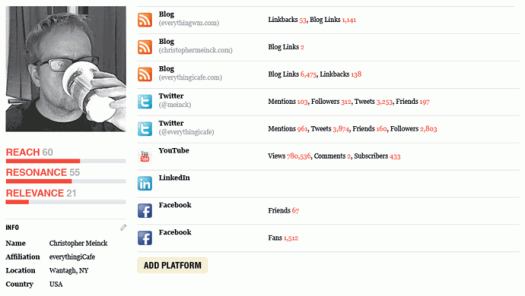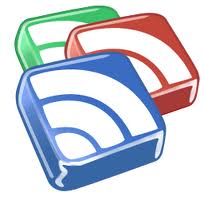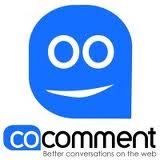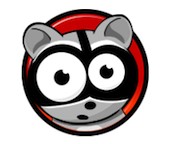The post 6 reasons your nonprofit should be a Big Listener appeared first on Socialbrite.
]]> Photo courtesy of CarbonNYC via Creative Commons
Photo courtesy of CarbonNYC via Creative Commons
How Big Listening can help your organization improve
Target audience: Nonprofits, cause organizations and advocates, foundations, NGOs, social enterprises, businesses, educators, journalists, monitoring services.
Guest post by Rachel Weidinger
Upwell
 I started Upwell from the premise that it might be possible to do really Big Listening with social media. Listening beyond a brand, a program or a campaign. My curiosity drove me to investigate:
I started Upwell from the premise that it might be possible to do really Big Listening with social media. Listening beyond a brand, a program or a campaign. My curiosity drove me to investigate:
● Can we listen to the tides of Internet conversation on an issue, and learn to predict and ‘surf’ them?
● Can we use the momentum of focused attention to raise an issue above the noise?
Upwell is a pilot project, testing the waters to transform the ocean conversation. Our team sifts through the vast amount of real-time online content about the ocean and amplifies it. The mission of Upwell is to condition the climate for change in marine conservation, and prepare people to take action.
After six months of trying and testing – and learning some hard lessons – Upwell has found a way to do Big Listening online, mostly using Radian6. Even better, we discovered that we can use this practice to both inform and measure campaigns.
“Big Listening is taking all the conversations that are going on online and trying to find pockets; in our case, ocean issues like MPAs (marine protected areas), overfishing, sustainable seafood, whales, bluefin tuna, ocean acidification, sharks and shark finning,” explains Matt Fitzgerald, Upwell’s curator and social metrics manager. “We’re listening for those conversations, and trying to meet those people where they are, rather than going out and saying, ‘This is the exact demographic profile of the person who we want to reach.’”
The core value of Big Listening is that it is important listen to each other at scale, and as individuals. Public opinion polls provide some types of insight, but take time and money. Big Listening is fast and shows changes over time.
Here’s the rundown of why your nonprofit should be a big listener:
Big Listening is the future of issue communications
1As technology costs drop and communications move online, the future of our work lies in Big Listening.
“Big Listening helps you to better identify opportunities,” says Ray Dearborn, Upwell’s senior curator and campaign strategist. “You can see conversations start to bubble up. If you jump in quickly enough, you can have a huge impact on what happens to those conversations.”
When we jump in, we can immediately assess our impact. The team at Upwell expends significant time and energy paying attention to the shifting target of what’s really going on with an issue.
“For the first time, we can really watch conversations develop, and watch the effects of campaigns that are being launched, in real, or close to real, time,” says Matt.
The tools we use to do this work are not immediately obvious. We primarily use Radian6, an enterprise-level social media platform most often used to monitor brands and products. We’re repurposing a commercial tool to monitor an issue, but using it in a very different way.
“Big Listening is actually harder than what major multinational companies are doing with their brand monitoring because conversations around issues and movements are constantly evolving,” explains Matt. “One day you can be talking about ‘hydraulic fracturing,’ the next day you’re talking about ‘fracking,’ and then the next day someone comes up with a new, more punchy word for it. Listening to that is very different than just plugging your organization’s name and the most common misspellings into one of these tools and watching the graphs move. With Big Listening the contours and locations of these conversations are constantly changing, so you have to pay attention.”
Big Listening gives you extra whomp to compete with the big guys
2The Big Listening approach allows you to identify more collaborators. It also helps illustrate that the orgs who you think of as competitors for funding are actually great collaborators on campaigns. For example, redundancy of messaging across many campaigns at many orgs can create a helpful sort of messaging resiliency. The insight gained from Big Listening isn’t a super power exactly, but some days it sure feels like it.
“It makes you more effective,” says Matt. “For nonprofits, and especially advocacy groups, the other side almost always has more resources. Big Listening allows you to work more effectively by identifying ways in which less work can have more impact.”
Big Listening gives you perspective on your impact
3As nonprofit communications professionals, it can feel impossible to measure some of our most vital impacts. Is there more or less love for the ocean than last week?
Will hunger ever gain Bieber-like prominence? Are people more compassionate to animals, more generous towards the homeless? Campaigning with Big Listening allows you to measure the impacts of your campaigns in real time. You’re able to learn a lot between your morning meeting and the end of the work day, and you’re ready to put what you learned into practice right away.
“In terms of thinking about strategy, it’s really grounding because it gives you an opportunity to see that the front page of The New York Times isn’t the world,” Ray observes. “If you’re doing Big Listening, you can understand that conversations are not just around one hub. They travel, they morph, they move into different platforms. If you forget to do Big Listening, you can really narrow your opportunity lens. Big Listening is grounding in that, if there’s a bad news story, you can see that it’s not as big as you thought it would be. If there is a good news story, you can see that a really motivated group of individuals can make it spread.”
Big Listening helps illustrate the danger of working alone, and the benefit of thinking of your work in a network context. With real-time insight into how a few influential evangelists can push a conversation to prominence, Big Listening helps my team stay hopeful as we work on the crisis the ocean faces.
Big Listening helps you select the right campaign targets
4The first week I started using Radian6 I decided I needed a bigger monitor. A much bigger monitor. I thought “I need a bigger window into the Internet. This one is too tiny.”
In the same way, Big Listening has forced us to see when we’re putting big effort into a tiny online conversation. And when modest effort can reshape a comparatively more massive conversation.
“We can compare the size of conversations quantitatively, as opposed to just going on our hunches. We originally started campaigning on marine protected areas, but then we realized that the conversation was really small in comparison to some other issues,” Matt says. “We still monitor the topic, but we realized that for the impact that we’re trying to have [raise the entire online ocean conversation], we need to work on a bigger conversation.”
Big Listening helps you identify which angle has the best ROI
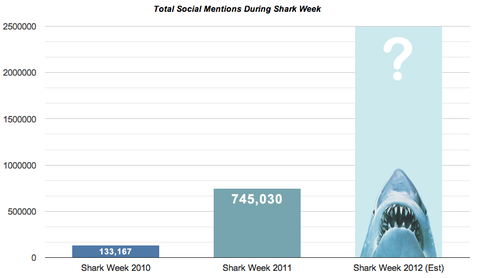
5Ray explains why Upwell chose to focus two weeks of Upwell’s campaigning on Shark Week. “We were able to identify an opportunity there because of the tools we have, and because we were able to compare it, we were able to understand what a huge opportunity it was. We were able to see the scale of it as compared to other things, like marine protected areas. That opportunity could have gotten lost if we didn’t have the tools to understand the scale and the sentiment.”
Big Listening helps you fail faster and learn more quickly
6At Upwell, we’ve all had to learn to campaign a new way. Each new staffer is challenged to run 8-10 campaigns that are small enough to be completed in a week, but still have big impact. Campaigning fast and with Big Listening demands new habits, and has big rewards.
“You can stop doing things that don’t work,” Matt says. Traditionally, people will roll out a communications plan, and there is at least a month building it up, and then the plan is for at least three months, and maybe up to a year. Once a campaign is running, resources have already been committed to very specific things.”
He explains, “Big Listening gives you the freedom to change the plan, and react to developments. We talk about the freedom to fail a lot. Failure can be much more informative if you can then act on what you learn from it. A shorter cycle. If it doesn’t take you six months, or nine months to realize that what you’re doing hasn’t worked, and it takes you a day, or a week, you can be a lot more nimble.”
Why you should be doing it, too
Big Listening has given the ocean a huge competitive advantage. I’m hopeful that more accessible tools will be created so that more people can practice Big Listening, and have the opportunity to powerfully transform the issues we dedicate our work days (and our lives) to. We have the chance to listen to our fellow humans at a new scale. At Upwell, we use the insight gained from Big Listening to craft measurable impacts on ocean issues, and we’re confident that it’s possible with other issues, too.
Rachel Weidinger is the director of Upwell, a nonprofit PR agency with one client – the ocean. You can see their work on the Tide Report or follow them on Twitter at @upwell_us to stay up to speed. This article originally appeared at Beth’s Blog.
 This work is licensed under a Creative Commons Attribution 3.0 Unported.
This work is licensed under a Creative Commons Attribution 3.0 Unported.
The post 6 reasons your nonprofit should be a Big Listener appeared first on Socialbrite.
]]>This is part of our ongoing series on how organizations can get the most out of Twitter. Please see below for other installments in this series.
The post How to use Twitter to monitor your brand appeared first on Socialbrite.
]]>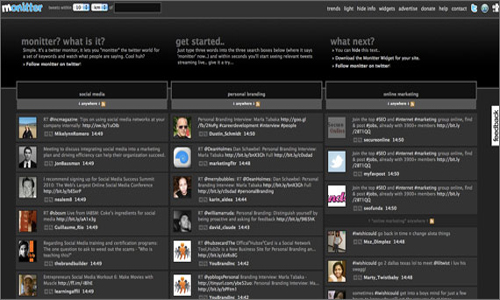
Monitter is one of the Twitter tracking tools reviewed below.
Tips & tools for tracking what’s being said about your nonprofit
Target audience: Nonprofits, NGOs, cause organizations, social enterprises, businesses, brands, bloggers, social media managers, individuals.
This is part of our ongoing series on how organizations can get the most out of Twitter. Please see below for other installments in this series.
By Lindsay Oberst
Socialbrite staff
 People are talking about your nonprofit, especially on Twitter. Research shows that one out of three Twitter users talk about brands in their tweets.
People are talking about your nonprofit, especially on Twitter. Research shows that one out of three Twitter users talk about brands in their tweets.  You don’t have the time to moniter your organization’s Twitter stream all day long, hoping to catch any mentions of your name. Thankfully, it’s easy to keep an eye on your brand. You can save time by setting up the right tools for your Twitter account. Below you’ll find plenty of options for monitoring mentions and tracking keywords so that you can respond to supporters promptly and analyze your results for success.
You don’t have the time to moniter your organization’s Twitter stream all day long, hoping to catch any mentions of your name. Thankfully, it’s easy to keep an eye on your brand. You can save time by setting up the right tools for your Twitter account. Below you’ll find plenty of options for monitoring mentions and tracking keywords so that you can respond to supporters promptly and analyze your results for success.
Twilerts: Twitter alerts via email
1Twilerts is a brand application that enables you to receive regular email alerts of tweets containing your brand, or whatever keyword you want to stay on top of. Think Google Alerts for Twitter. It allows you to track up to 10 queries, using its basic or advanced options, after creating a free account through your Twitter account or through Gmail.
Rating: ★ ★ ★
Platforms: Web-based
PeopleBrowsr & Kred: Social analytics for serious marketers
2PeopleBrowsr is a Web-based search engine for real-time conversations. The possibility to search bios and tweets by authority, location and links are among its Twitter features. But this is only the beginning, as this tool provides you with plenty of more options to keep track of your brand. It will even analyze tweets and classify them as positive or negative and track sentiments overtime. PeopleBrowser also offers full social analytics solutions with the ability to monitor Facebook, blogs and forums. With pricing beginning at $149 per month per seat, this is clearly an option for power users who really want to go deep with their tracking. Interestingly, the company announced last month that it’s offering a new service called Kred as a competitor to Klout.
Rating: ★ ★ ★
Platforms: Web-based
Sideline: Keep on top of key terms
3Sideline is a free monitoring tool from Yahoo! that lets you specify keywords to keep track of via an attractive downloadable app. It runs on Adobe AIR and is open source (though Yahoo! sticks an odd “all rights reserved” notice at the bottom). Sideline has advanced search features, including auto-refreshing of search queries and scanning trending topics. It also offers an Influencers tool to watch what important people are saying about a topic. Watch a four-minute screencast at Vimeo.
Rating: ★ ★
Platforms: Desktop
SocialMention: Social media search & analysis
4SocialMention lets you search keywords on Twitter; however, it also looks for mentions on 100+ social media properties. Place widgets of tracked searches on your website or create daily email alerts for searches. You can only search for one keyword at a time, although you can set up more than one alert. The dashboard, however, goes beyond only searching for your keyword; it also shows you sentiment, top related words, top users and top hashtags.
Rating: ★ ★ ★
Platforms: Web-based
Twitter: Lists and advanced search
5Twitter offers several free tools which can help you keep track of what’s being said of your brand. The ability to create Twitter lists can be hugely helpful if you keep them organized. Third-party apps, such as Hootsuite and Tweetdeck, make viewing lists easier. With the advanced search options, you can monitor negative impressions, questions and tweets by location.
Rating: ★ ★
Platforms: Web-based
Monniter: Live Twitter search
6Monniter is a free real-time Twitter search and monitoring tool. It allows you to narrow your search by geolocation, to set up multiple queries and to see them side by side. Plus, you can pause the monitoring of each column. Saved searches aren’t part of its options since you don’t have to sign up to use it. You can, however, place a keyword-tracking widget on your website.
Rating: ★ ★
Platforms: Web-based
SocialOomph: Boost your social media productivity
7SocialOomph will monitor the tweet stream for you and periodically email you a list of messages containing your specified keywords. You get a limited number of keywords with the free version, but it’s more than most other free tools allow. The professional version costs $27.97 per month. Socialbrite uses SocialOomph to auto-follow new followers — despite its awful interface.
Rating: ★ ★ ★
Platforms: Web-based
SproutSocial: Social media monitoring
8SproutSocial is an elegantly-designed social media dashboard which also allows for keyword tracking. You can aggregate your searches into one data stream to streamline your searches. It also helps you manage Facebook, Twitter, LinkedIn, Foursquare and other networks. The Pro version is $9 a month, while the Business version is $49 a month. Only the Pro version gives you the option to narrow keyword searches by location. They do, however, offer a 50 percent discount for nonprofits. Email [email protected] to request your discount.
Rating: ★ ★ ★
Platforms: Web-based
TweetBeep: Twitter alerts
9Tweetbeep lets you track conversations with hourly updates or daily emails. To use this service, you have to sign up and confirm by email. It will also track mentions of your website, even if tweets use a URL shortening service. You can set up 10 keyword alerts for free or upgrade to the Premium version for $20 a month, and get up to 200 alerts with a 15-minute alert option.
Rating: ★ ★
Platforms: Web-based
TweetAlarm: Keep an eye on Twitter keywords
10TweetAlarm allows you to track as many keywords as you like and gives you notices whenever you want — daily, weekly or as often as they find tweets that match your query. You can also ignore tweets from users of your choice, including from your own account.
Rating: ★ ★
Platforms: Web-based
Top photo via socialmouths.com
In this series on Socialbrite
• 8 nonprofit Twitter superstars
• 12-step guide on how to live-tweet an event
• 24 best practices for nonprofits using Twitter
• 7 top tools to measure performance & influence on Twitter
• Best Twitter dashboards for nonprofits
• 10 great get-down-to-business Twitter apps for nonprofits
 This work is licensed under a Creative Commons Attribution 3.0 Unported.
This work is licensed under a Creative Commons Attribution 3.0 Unported.
The post How to use Twitter to monitor your brand appeared first on Socialbrite.
]]>The post Best Twitter dashboards for nonprofits appeared first on Socialbrite.
]]>
Image by Joe Pemberton on Flickr
Choose one of these 7 tools to improve your Twitter workflow
Target audience: Nonprofits, NGOs, cause organizations, social enterprises, businesses, brands, bloggers, social media managers, individuals.
Summary: As Twitter becomes part of your routine — and especially if you manage multiple accounts — it’s easy to feel as if you’re floundering in the incessant flood of information. But a good Twitter dashboard (sometimes called an application or client) gives you access to your accounts in one place and can help you stay afloat by making it easier to monitor, plan and track updates and conversations.
Here we compare our top seven Twitter dashboards, as well as list others that may work best for you and your organization. Compare these to our earlier roundup of Top 10 social media dashboard tools.
This is the part of our ongoing series on how organizations can get the most out of Twitter. Please check back weekly for the next installment. Also see:

• 8 nonprofit Twitter superstars
• 12-step guide on how to live-tweet an event
• 24 best practices for nonprofits using Twitter
• 7 top tools to measure performance & influence on Twitter
By Lindsay Oberst
Socialbrite staff
 Twitter dashboards come in two types: desktop and Web-based. Which one best fits your organization depends on your preferences. While some people prefer to separate their Twitter and Internet experiences, other people find it easier to keep everything within the Web browser.
Twitter dashboards come in two types: desktop and Web-based. Which one best fits your organization depends on your preferences. While some people prefer to separate their Twitter and Internet experiences, other people find it easier to keep everything within the Web browser.
One downside of running a separate desktop client is that it can slow down your computer. However, even though Web-based solutions don’t require updates as do desktop ones, they also occasionally don’t work properly. Many of these clients also work on other platforms, including iPhones, Androids, iPads and others. All of these tools can be a bit daunting at first, so expect to spend some time getting familiar with them.
TweetDeck: An all-in-one desktop dashboard
1TweetDeck allows you to schedule tweets, to follow and unfollow accounts, and to create separate columns to track hashtags, keywords and Twitter lists. It also supports Geo-tagged tweets. You can track links using the url shortener bit.ly, and if you feel limited by 140 characters, a service called deck.ly allows you to tweet longer. The pop-up notifications can be helpful if you need to stay updated on a certain topic or keyword throughout the day. Unfortunately, you can’t filter the pop-ups but you can turn them off. On the negative side, this desktop tool has been known to slow some computers down since it uses Adobe AIR.
Twitter acquired Tweetdeck in May 2011, and although they have not done so yet, and haven’t shown any signs that they will, some people have concerns that Twitter might shut down Tweetdeck to protect itself. For now, this dashboard also simplifies Facebook, Myspace and Foursquare account management. Plus, its Android app gets the best reviews.
Rating: ★ ★ ★ ★
Platforms: Desktop, iPhone, iPad, Android
Hootsuite: Web-based productivity dashboard
2Like TweetDeck, Hootsuite can also schedule tweets, follow and unfollow people, and create separate tabs for monitoring. This intuitive dashboard has several useful features. First, it is designed to make collaborating and organization easy. Second, it offers free analytics, including a built-in url shortener, which tracks your tweeted links. Other useful features include displaying a user’s Klout score, which measures online influence, and a bookmarklet that allows you to tweet about a page without leaving your current tab. It also supports Facebook, LinkedIn, Ping.fm, WordPress.com, MySpace, Foursquare and mixi. Plus, real-time searches can be embedded on your website. On the downside, this client can fall asleep with inactivity, which disrupts any monitored streams.
The free version of this tool provides you with free social analytics, five social profiles and it’s ad-supported. Or you can opt for the $5.99 per month Pro version that allows you to have one team member, plus unlimited social profiles, enhanced analytics, no ads and more. The iPhone app is excellent for tweeting on the go. Hootsuite also continues to improve its service. Three updates announced this month provide geo-analytic technology, deeper integration with LinkedIn and crowd-sourced explanations of trending topics.
Rating: ★ ★ ★ ★
Platforms: Web, iPhone, iPad, Android, BlackBerry and Keitai
Seesmic: Powerful multi-platform tool
5If Tweetdeck and Hootsuite are for power users, Seesmic is for regular folks. The Seesmic Desktop offering is an Adobe Air application that integrates multiple Twitter accounts, Facebook accounts and pages. Seesmic also offers a browser-based client for Twitter that allows you to manage your Twitter stream in a Gmail-like interface; save your Twitter searches synchronized with your Twitter account; and hold threaded conversations in your direct messages (DM’s). Seesmic Desktop allows you to manage several Twitter accounts, build groups, create saved searches and utilize an anti-spam tool. Klout can be integrated into this client using an app; however, you won’t get analytics with this tool, and the Web and desktop versions have different features.
Rating: ★ ★ ★
Platforms: Desktop, Web, iPhone, iPod Touch, Android, Windows Phone 7, Blackberry
Mixero: Improving workflow, reducing noise
6Dubbed a “new generation Twitter client,” Mixero cuts out much of the distracting Twitter noise and allows you to manage multiple accounts without becoming overwhelmed. This desktop client runs on Adobe Air, but users report fewer glitches than similar applications. Many clients attempt to take over your computer and give you little control; however, Mixero gives you detachable, re-sizable columns. And they also have a unique Avatar mode, which allows the program to hide itself except for your ActiveList. The icon cluster stays on top of the desktop and shows when new items are received. This is great for not getting caught up with every little thing everyone is saying.
Its ActiveList allows you to choose a number of sources that are really important for you at the time. You can filter groups and create channels using keywords and user names. MicroChats give you the ability to create a private (or public) chat room and quickly invite your Twitter friends and followers to talk with you in real time. Another useful feature for getting work done is that the app allows you to create two dashboard setups, meaning you can have one for work and one for home. It also works with Facebook.
Rating: ★ ★ ★
Platforms: Desktop, iPhone, Android
Brizzly: A simple, Web-based reader
7Brizzly simplifies your Twitter browsing and allows you to manage up to five accounts for free; however, it does not allow scheduling. One neat thing about this tool is that it helps you keep up with news and trends and explains trending topics in its Brizzly Guide. This way your nonprofit can stay relevant. Also, when you get a direct message (DM,) an IM-like notification pops up which you can view and answer in the pop-up window. Another useful feature is that you can mute a user without unfollowing them. In June 2010, Brizzly launched picnics, a feature that allows you to exchange links, photos and comments with members of your nonprofit and without anyone else seeing them.
Rating: ★ ★
Platforms: Web, iPhone, iPad, Android
Other choices
We haven’t used all of these additional Twitter dashboards and clients — which ones do you think are worth a tryout?
- DestroyTwitter. A super simple desktop dashboard. It leaves an incredibly small footprint.
- EasyChirp. An alternative to the Twitter.com website, the site is designed to be easier to use and optimized for disabled users. Formerly called Accessible Twitter.
- UberSocial: A full-featured app with an excellent iPhone component. Also, available for Android and Blackberry.
- CoTweet: Wed-based social media engagement, management and reporting solution. Offers anayltics, although they are not intuitive.
- TwitterLocal: Good for connecting with local people and businesses.
- Twitterific: A Mac OS X and iOS client.
- Echofon : A minimalist client for Mac, also with a Firefox add-on.
- Pwytter : A free, open source Twitter client for Windows, Mac and Linux.
- Tweetie for Mac: A Twitter app for Mac (desktop and laptop) users. Note: Twitter purchased Tweetie2, an iPhone app, in April 2010.
- Digsby: Digsby combines IM, email and social networks in one app.
- Twinja : A downloadable desktop app built on Adobe AIR for those who prefer a different UI. Works on both Mac and PC.
- TwInbox : TwInbox seamlessly integrates Twitter into Outlook, giving you full Twitter functionality without having to open any other apps.
- Spaz: An open-source Twitter app for Mac OS X, Windows and Linux.
- Tweetr : Twitter client for Mac / PC.
- Twittm : Twitter for desktop.
- Statuzer : Twitter client running through Adobe AIR.
- Chirpr : Windows sidebar gadget for Twitter.
Have a favorite of these Twitter clients? Which ones do you like or dislike? Know of others we missed? Please share in the comments!
Additional Twitter articles on Socialbrite
• Top 10 social media dashboard tools
• 12 great nonprofits & causes to follow on Twitter
• Build a fan base: How to get more followers on Twitter
• Go viral: 13 ways to get your blog posts retweeted
• Twitter tutorials: Twitter Lists, hashtags, Twitter stats & more
 This work is licensed under a Creative Commons Attribution 3.0 Unported.
This work is licensed under a Creative Commons Attribution 3.0 Unported.
The post Best Twitter dashboards for nonprofits appeared first on Socialbrite.
]]>The post Find the influencers who matter most to you appeared first on Socialbrite.
]]>Traackr helps you keep track of the big kahunas in your sector
Target audience: Nonprofits, social enterprises, foundations, NGOs, cause organizations, brands, small businesses, media professionals
 There’s a lot of discussion these days around influencers. With the proliferation of social media, it’s no longer just about generating the conversations online, but now it’s also about who’s talking about you and what they’re saying. It can be helpful to keep tabs on those influencers so that you can engage with them, as well as get feedback on your work.
There’s a lot of discussion these days around influencers. With the proliferation of social media, it’s no longer just about generating the conversations online, but now it’s also about who’s talking about you and what they’re saying. It can be helpful to keep tabs on those influencers so that you can engage with them, as well as get feedback on your work.
This is where Traackr comes in. I received a three-month trial of the system and have been using it to gauge traction for the Blue Key campaign.
Much has already been written about the benefits of Traackr. If you haven’t read them, I’m pointing you to some great posts by Valeria Maltoni and Rick Liebling.
The main reason I’m a huge fan of the service is because with Traackr, it’s not about numbers, or how much you talk to someone on Twitter all day. It’s about context, relevance and therefore potential influence based on that contextual relevance. So you could, for example, have someone who is not very active on Twitter or Facebook but has a blog that is devoted to refugee and humanitarian issues. That’s someone I probably want to keep track of — and that’s the kind of thing Traackr lets me do.
You should know up front that Traackr is not cheap. It costs about $500 if you’re signing up for a list as a new account, and then the prices per list goes down. I was told that the founder may be considering alternative prices for small businesses, nonprofits or indie pros, but no word yet on when that will be.
How to use Traackr
Start out by identifying a particular area or topic that you’re trying to find online influencers in. For example, for the Blue Key campaign, one of my searches focused on refugees and humanitarian issues, i.e. people who are active online and who post frequently to any number of online channels about those issues.
Once you’ve identified these topic areas, make a list of keywords relevant to that topic area. You can set up to 50 keywords per search. As you’re doing so, Traackr will tell you how broad or niche that keyword is. You can also include Twitter hashtags and prioritize keywords. For example, here are the keywords I’d set up for this particular search (refugee and humanitarian issues):
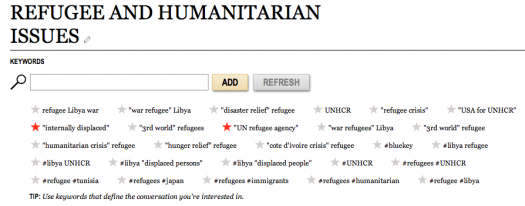
Once you’re satisfied with your list of keywords (you can test them as you go; Traackr automatically generates a list based on who in its database is using those keywords most frequently), you can activate your search. Then, Traackr starts crawling the Web based on your keywords.
When it’s had a few days to do so, it will give you an updated list of influencers based not simply on how active they are on Twitter or Facebook, but on how much they use those terms in as many of their digital properties as they’ve been able to identify. If you find that the Traackr database is missing one or more of their digital properties can add a property and once Traackr verifies it, it will be added to that influencer’s profile.
Traackr updates your influencer list on a weekly basis, and the list changes based on how frequently those on your list have been using your keywords. So it’s an active search, not a passive one.
5 ways to make Traackr work for you
1Traackr gives you an “A-list” of 25 people who are using your keywords the most. That A-list is what changes on a weekly basis, based on how frequently they are using your keywords. If you want to add more than 25 influencers to your list you can, but that will cost you. How much, I don’t know, so you should try it out and see if that list of 25 is giving you what you need before you try to extend it (you can delete people if you decide they’re not relevant for you).
2You can change your keywords as you need to, but I would suggest you spend a lot of time putting together your initial list (their customer service is terrific and will help you review them). Then activate your search when you think your list of keywords is really solid.
3Traackr won’t give you an “influencer score.” Derek Skaletsky, who works with the company (and who is also, coincidentally, the creator of Propz), made this very clear in a recent blog post. Yes, it will give you a list of people who use those keywords most frequently, and they will be ranked on your list based on that frequency, but it’s nothing like a Klout score.
4The list won’t do your work for you. Just like you need to make sure your PR pitches don’t suck, you need to take the list for what it is – a starting point for you to identify people who are active online (and we all know the difference between being active online and offline, right?) in the area you’re interested in, so that you can start to build relationships with them and move your campaign ahead.
5As of now, you can’t segment influencers by geography. However, if you are focusing on a particular geographic area, look carefully at their “footprint” in Traackr and delete those who aren’t relevant to your search (see example below).
Because of the way Traackr focuses on topics rather than simply activity on Twitter and Facebook, I think it’s a real winner.
Have you tried Traackr? If so, what do you think? Are there other influence tools you’ve found useful? Please share in the comments.
 This work is licensed under a Creative Commons Attribution-NonCommercial-ShareAlike 3.0 Unported.
This work is licensed under a Creative Commons Attribution-NonCommercial-ShareAlike 3.0 Unported.
The post Find the influencers who matter most to you appeared first on Socialbrite.
]]>The post How to build & manage a monitoring dashboard appeared first on Socialbrite.
]]>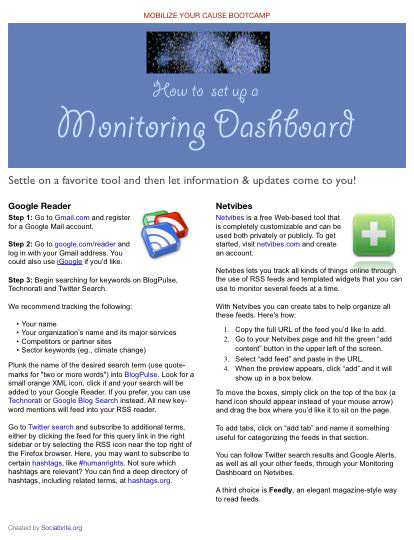
Download this one-page flyer to get set up in Google Reader or Netvibes.
Settle on a favorite tool and then let info & updates come to you!
Target audience: Small to mid-size nonprofits, cause organizations, agencies, brands, NGOs, Web publishers, individuals. This is part of our series on social media monitoring:
• Guide to monitoring social media conversations
• 20 free, awesome social media monitoring tools
• 10 paid social media monitoring services for nonprofits
 Last year a study of the 200 largest U.S. nonprofits and found that they’re using social media at a faster clip than the business community or academia for the third year in a row. Some 8 percent more charities are monitoring social media over the previous year’s figures. (See the 10-page findings from UMass Dartmouth — PDF.)
Last year a study of the 200 largest U.S. nonprofits and found that they’re using social media at a faster clip than the business community or academia for the third year in a row. Some 8 percent more charities are monitoring social media over the previous year’s figures. (See the 10-page findings from UMass Dartmouth — PDF.)
But how deep-seated are their efforts? Setting up a Google Alert does not mean you have a monitoring program. And 79 percent in another survey said they hadn’t found ways to incorporate social media tools effectively into their operation, according to the Chronicle of Philanthropy.
During the series of social media bootcamps and presentations that the Socialbrite team has been conducting around the country, one of the most popular how-to’s has been our instructional on how to set up a free monitoring dashboard — or listening station, if you prefer that term.
There are a few things to consider before starting. First, how does a monitoring dashboard fit into your overall communications strategy? Let’s review:
• You should have an overall Social Media Plan that outlines your organization’s end goals and who’s responsible for what deliverables. (Never start with the tools.)
• You should have a Social Media Policy in place.
• You should settle on one of these social media dashboard tools to manage most of your social media activities.
• Supplement that with a select few free monitoring tools, plus perhaps a paid service or vendor if you have the budget.
• Finally, don’t forget a monitoring dashboard to keep on top of everything else. Some paid services incorporate this component, but today we’ll discuss the free variety.
Why do you need a monitoring dashboard in addition to your social media dashboard? Because the free monitoring tools like Hootsuite and Tweetdeck will plug you into conversations taking place on Twitter and, to a lesser extent, Facebook, but won’t connect you with blog posts, comments, forums or search results. (The paid social media dashboard services are beginning to pull all this into one place.) A monitoring dashboard is the place where you’ll be able to gather and organize all your favorite RSS feeds in one place. For instance, you’ll be able to see headlines from dozens of the most important blogs in your sector at a glance. And you’ll be able to see alerts, search results, new photos and even tweets in your dashboard.
In this tutorial we’ll look at two things: How to build your dashboard, and then how to manage it.
How to set up your monitoring dashboard
First, select a favorite news reader. We like Google Reader, but Bloglines, Feedly, iGoogle or other news readers will also do. Some folks prefer Netvibes, which pre-populates your dashboard with top feeds from the sector, like this High-tech news dashboard. (Click on the image at top to download a one-page handout that takes you through the steps for either Google Reader or Netvibes.)
Here’s all it takes to set up a dashboard in Google Reader to monitor your brand:
Step 1: Go to Gmail.com and register for a Google Mail account, if you don’t have one.
Step 2: Go to google.com/reader and log in with your Gmail address.
Step 3: Begin searching for key terms on Google Blog Search, Technorati, BlogPulse or Twitter Search to identify the searches that you want to automate.
We recommend tracking the following:
- Your name
- Company name
- Brand mentions (specific programs, products or services)
- Upcoming events or conferences
- Competitors’ names
- Key phrases in your sector (hunger relief) or industry (cloud computing)
Place the name of the desired search term (use quotemarks for “two or more words”) into Google Blog Search and do the search. On the search results page, click the RSS link in the left sidebar and you should see an “Add to Google Reader” button.

Select it and your search will be added to your dashboard. (Alternatively, if you have Google Reader open on another tab in your Web browser, you can right-click on the page’s RSS link, select Copy Link Location, navigate to your Google Reader tab, click Add a subscription, and paste the link in there.)
Let’s say you created a feed for “homelessness” through Google Blog Search. Whenever Google finds a new reference to your search term on a new blog post, it will automatically appear in your RSS reader. You’ll want to repeat this process for every term you want to monitor.
Step 4: Now let’s have some fun! Go to Twitter search and subscribe to additional terms, either by clicking the feed for this query link in the right sidebar (pictured here):
![]()
or by selecting the RSS icon at the right of the Firefox browser’s main search field (pictured here):
![]()
We recommend that you subscribe to certain hashtags that apply to your sector, like #malaria; here’s how the RSS feed looks: http://search.twitter.com/search.atom?q=%23malaria. For inspiration, see our directory of 40 hashtags for social good.
In addition, there may be occasions where you want to conduct an Advanced Search on Twitter, such as tweets from a particular person or organization; tweets since a certain date; tweets near a geographical location; tweets in another language, etc. You can subscribe to any of these searches.
You may also want to go to Google Alerts and have your alerts show up in your monitoring dashboard rather than in your email in-box.
Google Reader also offers a few other goodies, like the ability to share articles with others privately or publicly, although this is somewhat cumbersome. Amy Sample Ward uses Netvibes to publicly share some of the feeds she subscribes to.
Manage your monitoring dashboard: 5 steps to success
Now that you’re up and running, you’ll want to be strategic about what to monitor and who’s doing the monitoring. Are you the lone-wolf social media point person, or do you have several team members charged with keeping a finger on the community pulse? Either way, follow these five steps to success:
1Create checklists. Begin by reviewing the Community Insights Checklist (covering broad goals) and the Keywords Checklist (identifying specific key terms) in our Guide to monitoring social media conversations — and create checklists tailored to your organization.
2Organize your feeds and alerts.Next, organize your dashboard so that you’re targeting the right blogs, alert terms, search terms, Twitter hashtags, etc. Add new feeds to monitor to your Google Reader. Group your feeds into separate folders. Select the Feed settings tab at the top of Google Reader, select New folder, and you’re on your way.
3Be selective. What to do with all the information that starts to pour in? Don’t stress about keeping on top of everything — you’re checking the pulse of the community, not trying to micro-manage every conversation. Be selective in the conversions you join and in the information you pass along to co-workers.
4Start engaging. We recommend interacting with and engaging the most influential individuals (bloggers, Twitterers and commenters) in your network, as long as you’re providing genuine value. Do, however, respond to anyone who interacts with you.
5Act on key learnings. The point of monitoring is not to gather but to disseminate — to act on the information that’s most meaningful. That means not just tweeting but fashioning regular reports, updates and takeaways about what the community is saying and feeding it into the right channels: communications/marketing, program development, the website UI/design team and your organization’s equivalent of customer support, market research and campaign measurement. Create a regular feedback loop that funnels community insights into all areas of your organization.
This is only one way to build and manage a monitoring dashboard. What has worked for you? Please share in the comments!
Related
• Free handouts on social media (Socialbrite)
• Guide to monitoring social media conversations (Socialbrite)
• 20 free, awesome social media monitoring tools (Socialbrite)
• 10 paid social media monitoring services for nonprofits (Socialbrite)
• More monitoring articles (Socialbrite)
• Metrics articles (Socialbrite)
 This work is licensed under a Creative Commons Attribution 3.0 Unported.
This work is licensed under a Creative Commons Attribution 3.0 Unported.
The post How to build & manage a monitoring dashboard appeared first on Socialbrite.
]]>The post 10 paid social media monitoring services for nonprofits appeared first on Socialbrite.
]]>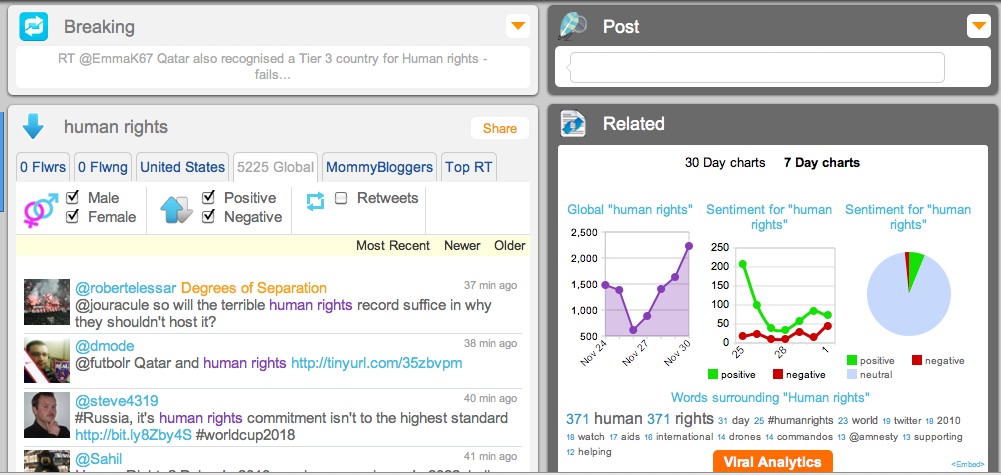
Twitter data galore: A screen grab from ReSearch.ly.
Trackur, Sprout Social, Thrive & other monitoring tools worth paying for
Target audience: Mid-size nonprofits, cause organizations, agencies, brands, NGOs, Web publishers, individuals. This is part of our series on social media monitoring:
• Guide to monitoring social media conversations
• 20 free, awesome social media monitoring tools
• How to create & manage a monitoring dashboard
 Search engines and free monitoring tools can help you find mentions of your brand easily, but if you want to take your social media efforts to the next level, you may want to consider using a social media monitoring vendor.
Search engines and free monitoring tools can help you find mentions of your brand easily, but if you want to take your social media efforts to the next level, you may want to consider using a social media monitoring vendor.
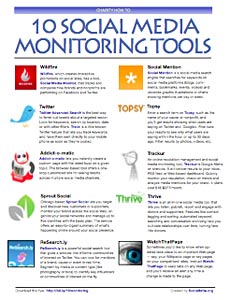
Once your nonprofit or business reaches a certain size — with, say, hundreds of daily mentions — a paid social media monitoring vendor or service can help you smartly assess the conversations taking place about your brand. In many cases, they offer tools for you to respond and forge deeper levels of engagement. A good paid service will offer not just data but ways for you to draw insight and develop strategy by tapping into actionable intelligence.
Paid subscription services for social media monitoring can save staff time and provide insight into influence, authority, sentiment and reach. But remember: For your social media program to work, you’ll need to designate someone on your staff to own this. The person or team should analyze the results, act on time-sensitive issues and make recommendations about how to integrate the learnings from the community into your operation. (Socialbrite can help you get your program up and running.)
Social media vendors come in all shapes and flavors. Some cater to small organizations with modest budgets that want to handle monitoring internally. Others service large nonprofits and corporations that want a robust suite of tools and access to expert analysts. So we’ve broken this package into two parts:
• 10 paid social media monitoring services for nonprofits (below)
• Top 20 social media monitoring vendors for business (on our sister site, Sociamedia.biz), which includes Radian6, Lithium and 18 other vendors that work with nonprofits
Please note that we’ve already covered a number of monitoring services in our roundups Top 10 social media dashboard tools and 14 free tools to measure your social influence — including TweetDeck, CoTweet, Seesmic, Spredfast, MediaFunnel, Bit.ly and others — so think of this as a package of monitoring resources.
Commercial social media monitoring services
Here is our guide to 10 subscription-based social media monitoring services for nonprofits and organizations, with the most affordable ones listed first. Have your own favorites? Please add them in the comments below.
Trackur: Affordable tracking & engagement
1An online reputation management and social media monitoring tool created by reputation expert Andy Beal and team, Trackur is sort of a Google Alerts on steroids. Trackur provides all the monitoring tools you need. It is brandable, will rate the sway power of your influencers for prioritized responses and will deliver results to your inbox, RSS feed or Web-based dashboard. Quickly monitor your reputation, check on trends and analyze media mentions for your company, brands, sector, cause or clients. Cost: Four plans range from $18 to $377/month and vary depending on number of searches and features used. Free 10-day money-back guarantee. Clients: 27,000+ users. Affordability makes it popular among small businesses. Owner: Independent.
Sprout Social: Track & grow your social footprint
2We’ve heard good things about Chicago-based Sprout Social, which lets you target and discover new customers or supporters, monitor your brand across the social Web, organize your social networks and manage up to five identities with the basic plan. The service offers an easy-to-digest summary of what’s happening online around your social presence. Cost: Pro Plan at $9/month is geared to small, independent businesses, nonprofits and organizations. Business Plan at $49/month is tailored to larger companies. Free trial. Clients: Chiefly small businesses, independent service providers such as attorneys and real estate agents, bloggers. Owner: Independent.
uberVU: Affordable for smaller operations
3A social media monitoring tool that combines powerful features (e.g., historical and real-time data, sentiment analysis, platform filtering) and ease of use, uberVU offers a monthly price that should be more attractive to nonprofits and small and mid-size brands. Cost: Four packages:$49.99/month for individuals, $180/month for popular Plus program, $400/month for big companies, contact team for PR agencies. 14-day free trial. Clients: OMD, Edelman, Sharp. Clients generally consist of small businesses and startups, PR & marketing agencies, bloggers. Owner: Independent.
Thrive: Convert fans into donors
4Thrive, from the consultancy Small Act of McLean, Va., is an all-in-one social media tool that lets you listen, publish, report and engage with donors and supporters. Features like contact tagging and sorting, automated keyword searching and automated conversation archiving help you cultivate relationships over time, turning fans into donors. Import your existing email lists and convert them into detailed social profiles so you can jump-start your social media program. Small Act is also launching a service that takes an organization’s donor database to help them build social communities from that data. Cost: Recommended plan for most nonprofits is $1,188/year per user ($99/month per user). Small Act offers a one-month free trial as part of the contract if requested. See the demo, too. Clients: AARP, KaBoom, Global Giving, Ashoka, Office Depot, National Geographic. Owner: Independent.
ReSearch.ly: Newcomer packs a lot of power
5Launched in December 2010 and in development for two years, ReSearch.ly — from the folks behind Sydney- and San Francisco-based PeopleBrowsr — is essentially a powerful social search tool that gives a window into informal communities of interest on Twitter. You can look for mentions of a brand, cause or event in real time, filter out unimportant mentions and funnel in all Twitter users, Twitter folks you’re following or just your followers. Segment by media or content type (like photography or bios) to identify key influencers or communities of interest on the fly. We got an advance look at ReSearch.ly at BlogWorld Expo and liked what we saw. Cost: $99/month per user. The cost quickly goes up if you want to add data from Facebook, blogs and other networks. Clients: New service. Owner: Independent.
eCairn: Conversation & influencer mining
6Find your tribes, rank your influencers, listen to the people who matter and engage in meaningful conversations with eCairn Conversations. This video on YouTube describes a number of enhancements — campaign management, influencer geo-location, relevance filtering — released in November 2010. Cost: Pricing starts at $99/month. Clients: HP, Chanel, L’Oreal and several PR and communication agencies. Owner: Independent.
Hootsuite: Integrate your social platforms
7We like Hootsuite because we think of monitoring as part of an integrated approach to social media. (Other monitoring dashboards offering tiered pricing include TweetDeck, CoTweet and Seesmic.) With Hootsuite you can update multiple social media platforms (Twitter, Facebook and more) from a computer or mobile device. Your team can track results of their interactions and create a dashboard that will work efficiently with their preferred social streams. Social Insights, which comes with the Pro editions, gives you access to information about your social network and intelligence about how to enlarge your network and adjust your marketing strategy. Cost: For $5.99/month, your organization can enjoy unlimited capabilities for a single user, with each additional user costing $15/month. Clients: The White House, Oxfam, Martha Stewart Media, SXSW, Zappos, TED, LA Times, Fox, BET. Owner: Independent.
Actionly: Low cost and no frills
8Actionly tracks keywords across Twitter, Facebook, blogs, Flickr, YouTube, etc. and pulls updates every hour. The information is gathered, analyzed and stored in an easy-to-use dashboard that allows you to manage multiple Twitter or Facebook accounts and lets you export all data for future use. The service also offers customized reports, email alerts and sentiment analysis, and its integration with Google Analytics allows you to see your social media ROI. See this tutorial on how to use Actionly strategically. Cost: Basic monitoring for $20/month, premium for $50/month and a Pro option at $100/month. Free one-search trial. Clients: Public relations professionals, others. Owner: Independent.
BuzzStream: Build & manage relationships
9BuzzStream helps you build a dossier about your influencers. Search mainstream news, blogs posts, blog comments, Twitter posts, forums, message boards and many other social sites for mentions of your keywords. Cost: Pricing starts at $49/month for one person and 10,000 search results, $99/month for three users. If you monitor social media to find link opportunities or conduct reputation management, you can set up media monitoring searches in BuzzStream starting at $29/month. Clients: Sapient, Rubbermaid, Random House, HomeAway, Bazaarvoice. Owner: Rel Equals, Inc.
Meltwater News: Mixed reports
10Meltwater News combines broad search capabilities, analytical tools and a consultative relationship with its clients. Through its Web-based interface, users can evaluate trends, map press activity, identify target markets and measure the ROI of marketing and PR campaigns. Track keywords, phrases and topics from 130,000 sources and receive daily reports. We’re reluctant to recommend Meltwater News, however, based on some recent feedback. Cost: In line with other basic monitoring services. Clients: Meltwater News has more than 20,000 clients, including Airtran Airways, European Tour, USA Cycling. Owner: Meltwater Group. Its nonprofit arm, the Meltwater Foundation, operates the Meltwater Entrepreneurial School of Technology. Also see: Meltwater Buzz in Top 20 social media monitoring vendors for business.
Other paid social media monitoring solutions
There are more than 200 social media monitoring services in the marketplace, so this is meant as a sampling of some of the notable vendors that would be of most use to nonprofits and small to mid-size organizations and businesses rather than a comprehensive list. If you’ve had success with other vendors, please your experiences in the comments below.
More social media monitoring vendors and tools:
• Top 10 social media dashboard tools (Socialbrite)
• 14 free tools to measure your social influence (Socialbrite)
• Socialmedia.biz’s Top 20 social media monitoring vendors for business includes a host of vendors that also cater to nonprofits, including Radian6, BuzzGain and many others.
Related
• Social media monitoring: Articles (Socialbrite)
• Social media metrics: Articles (Socialbrite)
 This work is licensed under a Creative Commons Attribution 3.0 Unported.
This work is licensed under a Creative Commons Attribution 3.0 Unported.
The post 10 paid social media monitoring services for nonprofits appeared first on Socialbrite.
]]>The post 20 free, awesome social media monitoring tools appeared first on Socialbrite.
]]>
Take the pulse of the social Web by hitting these rich targets
Target audience: Nonprofits, cause organizations, brands, businesses, NGOs, educators, independent publishers, individuals. In this social media monitoring series:
• Guide to monitoring social media conversations
• 10 paid social media monitoring services for nonprofits
• How to build & manage a monitoring dashboard
 Ready for a listening program? There are a wealth of free monitoring tools to choose from.
Ready for a listening program? There are a wealth of free monitoring tools to choose from.
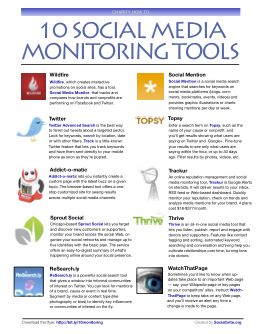
Free monitoring tools may fill your needs if you work for a small nonprofit or your business has no need for more sophisticated services (coming tomorrow). Just remember: Free monitoring tools aren’t really free — they require an investment of staff time and analysis.
And a word of advice: Don’t begin with the tools. Begin with a strategy — a social media game plan. Think of this as a multi-step process: Listen, learn, engage, act and measure. Listening is only the first step — you need to take action on what you discover. (Socialbrite can help you with an integrated approach to social media.)
Yesterday we covered why monitoring is essential to your organization. Today we’ll look at the wealth of free monitoring tools available to you, divided by functionality.
Here is our Guide to Free Social Media Monitoring Tools. Have your own favorites? Please share in the comments.
Monitor social campaigns
Wildfire: How is your brand performing in social?
1Wildfire, a startup focused on creating interactive promotions on social sites, last month launched Social Media Monitor, a tool that tracks and compares how brands are performing on Facebook and Twitter. Wildfire allows companies, small businesses, marketing agencies, nonprofits and bloggers to create their own branded interactive campaigns — including contests, giveaways, incentive-based surveys and sweepstakes — and to simultaneously publish them in multiple social networks and on their websites. More than 65,000 users have done so. As we understand this, the basic tools are free and Wildfire also sells premium services.
Monitor social networks & blogs
Social Mention: Widgets & social search
2Social Mention is a social media search engine that searches for keywords on social media platforms — including blogs, comments, bookmarks, events, news, videos and microblogging services — and provides metrics around keywords and “sentiment.” It also provides graphic illustrations or charts showing mentions per day or week. Download the free search bar for your browser and monitor anything from your brand to your cause. They also offer APIs and provide coding for your own keyword monitoring widgets.
Alternative:
• Collecta lets you enter any search term to receive real-time results for mentions in social media, in blog comments and on news sites.
Google Reader: Begin with a dashboard
3Social media monitoring begins with a dashboard. (See our Top 10 social media dashboard tools.) A good choice to begin your monitoring is Google Reader: Subscribe to the RSS feeds of top blogs in your sector, competitors’ sites, news sites, Twitter searches and more, all in one place. You can even subscribe to searches on sites like Flickr and YouTube, so you’ll get an update on any new image or video that matches your brand or cause. If the page you’re on doesn’t seem to have an RSS feed, try Feedyes.com. We also like Feed Informer, which lets you splice multiple feeds together into one and filter for duplicates.
Alternatives: Bloglines, Netvibes.
BlogPulse: Take the pulse of the blogosphere
4BlogPulse from NM Incite is an automated trend discovery system for blogs that analyzes and reports on daily activity in the blogosphere. You can keep on top of key phrases, top blog posts, videos, key people news sources and more. But its real power lies in the options you have to track blog conversations based on topics or keywords. See which blogs, news posts, etc., are fueling the most conversations about your brand online.
Other blog monitoring services that should be in your arsenal:
• Google Advanced Blog Search
• IceRocket
Alltop: Identify the top blogs in your sector
5Alltop, Guy Kawasaki’s online magazine rack – or, more precisely, topic-based directory — lets you search for influential blogs in a given niche or subject. Add the feeds to your RSS reader and you have a more targeted monitoring process.
Monitor Twitter & Facebook
Hootsuite: Simplify your social efforts
6We’re fans of Hootsuite as a free tool that enables nonprofits and cause organizations to update multiple social media platforms (Twitter, Facebook) from a computer or mobile device. The free version lets you work with up to five social networks and two RSS feeds but is limited to one user for your organization’s account; it stores stat history for 30 days and is ad supported. For the paid version, see 10 paid social media monitoring services for nonprofits.
Alternatives:
• Tweetdeck
• Seesmic
• Cotweet

Twitter search options
7If Hootsuite or one of the other Twitter dashboard services doesn’t meet your needs, you have lots of other options to keep tabs on the Twitterverse. Here are a few:
- Twitter Advanced Search is the best way to ferret out tweets about a targeted sector. Look for keywords, search by location, date or with other filters.
- Track is a little-known Twitter feature that lets you track keywords and have them sent directly to your mobile phone as soon as they’re posted.
- Monitter lets you monitor Twitter for key words, phrases and topics being discussed online at a glance (though we still prefer Hootsuite for this).
- Twazzup is a dashboard program that monitors Twitter, Twazzup will let you know wheneer your keywords are mentioned in a tweet.
- PostRank analytics lets you uncover your influencers, identify which social networks give you the greatest traction and benchmark yourself against the competition.
- Pulse of the Tweeters uses data mining and sentiment analysis to mine millions of tweets and find the most influential people on Twitter around your cause or sector.
- Twitscoop lets you search and follow what’s buzzing on Twitter in real time.
- Twilert sends you emails when it sees keywords on Twitter that you specify.
- Sideline from Yahoo! allows users to create and group custom queries by topics of interest.
- PeerIndex is another option to help you discover authorities and opinion makers around a particular topic.
- MyTweeple checks out your Twitter account and analyzes who is following you back — a good way to monitor reciprocal relationships.
- MentionMap is a visualizer tool that lets you assess the most influential Twitter users in various sectors.
- Twitterfall is a great way to keep up on conversations about an event, or an online chat, using hashtags. You can also use its geolocation panel to see discussions in a geographic area.
Facebook Search: Explore FB conversations
8There are rich conversations taking place about your sector on Facebook right now. So don’t overlook Facebook Search as a monitoring tool. Unearth the people on Facebook who are talking about your brand or cause. Use the Facebook search field and then choose “Posts by Everyone” in the left navigation. You may find new Pages to Like and new people to interact with.
• Openbook may also be useful in turning up mentions of your brand in Facebook status updates.
Monitor upcoming events
Plancast: Stay on top of upcoming events
9Like many of my colleagues, I’ve ditched Yahoo’s Upcoming and moved to Plancast. You can subscribe to get an RSS alert on any new event that matches keywords you select. Keep track of events thrown by your competitors, or stay on top of conferences you may want to attend or co-sponsor.
Monitor with alerts
Google Alerts: Your real-time personal assistant
10Nearly every plugged-in user these days knows about Google Alerts. When Google’s vast army of bots discover a new blog entry or news story that contains a keyword or phrase you specify, it will send you an alert in a time frame you designate: immediately, daily or weekly. What’s more, you can receive alerts via feeds sent to your RSS reader. Enter the topic you want to monitor, then click preview to see the type of results you’ll receive. Keep current on your brand, cause, sector or industry — and, of course, mentions of your own name. Also keep in mind that Google Alerts tracks only content indexed by Google.
Related:
• A new service, Google Realtime Search, lets you search the social Web (chiefly Twitter) and create email alerts for search terms.
• TweetBeep is sort of a Google Alert for Twitter. It uses search.twitter.com site for mentions of up to 10 keywords or phrases you specify and will send you emails.
BackType: Track comments & influencers
11BackType Alerts is a free service that sends you email updates whenever a search term is mentioned in a comment. Somebody trash your brand in a blog comment? You’ll want to know right away. BackType will also show you your Twitter influencers who are sharing related links.
Update: BackType was acquired by Twitter in 2011 and is now closed.
Yahoo Pipes: Mash up your content feeds
12Yahoo Pipes is a powerful tool that lets you aggregate and remix content from anywhere online. Its visual interface makes it fairly easy to use. You can use it in innumerable ways — for example, to track Twitter for mentions of your brand, to monitor multiple feeds or to alert you only when feed activity meets a certain activity threshold. For a good example of Yahoo Pipes in action, look at this Social Media Firehose tool, which lets you track your brand or product mentions across a slew of social media sites.
Northern Light: Roll your own search alerts
13Remember the days when editorial filtering counted for something? Northern Light Search has been around forever, it seems. A business research tool, it indexes more than 800 news sources and publications, like the Wall Street Journal and PBS NewsHour, and some 1,600 authoritative industry blogs. They write: “We have editorially honed the content to include only business sources and to exclude the shopping and other consumer sites that clog your results on other search engines.” It offers support for full Boolean queries as well as saved search and alerting capabilities. You can create Search Alerts via email or RSS to help you track subjects you care about.
Monitor with social search
Addict-o-matic: Check the buzz about a topic
14Addict-o-matic lets you instantly create a custom page with the latest buzz on a given topic. The browser-based tool offers a one-stop customized site for seeing results across multiple social media channels.
Alternatives:
• Guzzle reads hundreds of feeds on social media sites every second to help you keep abreast of stuff you care about.
• Buzzoo is a buzz aggregator drawing from multiple sources.
• BuzzFeed sports a robust buzz-detection algorithm.
• Twendz, a free tool from Waggener Edstrom, piggybacks off Twitter Search to offer user sentiment in real time.
• Social Seek will tell you who’s making the most noise about your brand.
• How Socialble? sizes up how visible your brand is on the social Web.
• Mon.itor.us is a free website, server and traffic monitoring service.
• See more choices under Twitter, above.
MonitorThis: Browse 26 search engines
1577elements’ monitorThis is a meta-search engine (remember those?) that let you comb through 26 search engines to look for blog posts, news articles, photos, tags and tweets on a specific subject. You may be surprised by some of the results on the more obscure search engines.
Alternative:
• Keotag lets you search multiple search engines, create social bookmark links around a topic or see who has used your brand as a tag.
Monitor comments & forums
Comment Sniper: First mover advantage
16If you have the staff to help manage your brand’s reputation in a deep way, then Comment Sniper is worth a look. Comment Sniper offers you a way to build targeted traffic to your site at no cost by giving you the opportunity to be the first to comment on relevant blog posts about your brand or sector. You set up blogs you want to monitor, and Comment Sniper sends you a desktop notification or text message to your mobile device whenever a new post goes up. Check this tutorial on how to make the process more efficient.
coComment: Keep track of conversations
17coComment is a Web service and Firefox plug-in that helps you keep track of blog comment threads. Whenever there is an update, such as a new follow-up comment, coComment notifies you instantly. It’s a handy service that saves you the trouble of checking back on blogs that don’t offer a comment notification feature.
Alternatives:
• Commentful is another Web service that helps you keep track of blog comments.
• Omgili (Oh my God I love it) forum search engine lets you find communities, message boards and discussion threads about any topic.
• co.mments helps you keep track of conversations.
BoardReader: Monitoring 50,000 forums
18Not all forums and message boards are indexed by Google. BoardReader is a community search engine that crawls forums, blog posts, images and microblogs. It’ll also let you know when a new forum starts specifically to discuss your brand or organization.
Other forum search & alert tools:
• BrandMentions Brand Tracker
• Big Boards
• Yuku Find
Monitor trends
Google Trends: Take the long view
19Google Trends gives you a measurement of the impact that bloggers or a campaign has on a brand. The tool measures the level of interest in specific topics based on searches people conduct over a period of time. One interesting facet is that you can compare multiple sites in the same sector and see the geographic regions where a keyword is most popular.
Related: With Google Insights for Search, you can compare search volume patterns across specific regions, categories, time frames and other properties.
Other choices:
• Trendpedia blog search from Attentio
• Social Trends from Viralheat
Monitor Web pages
WatchThatPage: Keep a watchful eye
20Sometimes you’d like to know when updates take place to an important Web page — say, your Wikipedia page or key pages on your competitors’ sites. Instruct WatchThatPage to keep tabs on any Web page, and you’ll receive an alert any time a change is made to the page.
Alternative: Copernic Tracker ($40)
More free social media monitoring tools
Several companies offer free, limited accounts for commercial tools through the “freemium” business model — not just a free trial but an ongoing free basic service — including:
- Alterian SM2 allows you to search up to five terms with a total limit of 1,000 results, however, there are no real-time alerts, geography or language filters or advanced searches.
- Trackur
- Looxii
Related
• Top 10 social media dashboard tools (Socialbrite)
• 14 free tools to measure your social influence (Socialbrite)
• Monitoring articles on Socialbrite
• Metrics articles on Socialbrite
• How to set up Google Alerts (eHow)
• Listening Tools for Social Media Monitoring (Janet Fouts)
• Four Methods and 40 Tools for Listening (Mission Creep)
The post 20 free, awesome social media monitoring tools appeared first on Socialbrite.
]]>The post Guide to monitoring social media conversations appeared first on Socialbrite.
]]>
Image by √oхέƒx
 on Flickr
on Flickr
How & why your organization should be tuning in the social Web
 Most brands and nonprofits have received the memo: To succeed in today’s interconnected world, you need to listen to what your supporters and customers are saying about you. With the new year still fresh, you may be finally ready to put into place a listening program to tap into the conversations taking place on the social Web about your organization or sector.
Most brands and nonprofits have received the memo: To succeed in today’s interconnected world, you need to listen to what your supporters and customers are saying about you. With the new year still fresh, you may be finally ready to put into place a listening program to tap into the conversations taking place on the social Web about your organization or sector.
Social media has blown apart yesterday’s top-down communication funnel and replaced it with a peer-to-peer model of empowered citizens and producers. People are tiring of mass media and prefer to listen to their peers’ recommendations about products, services and causes. It’s no longer just about driving people to your website. Today the action revolves around a complex set of social conversations outside of your control — but not outside of your influence. Even the most technically unsophisticated users can now use social tools to spread their messages with unprecedented ease. So what are they saying about you?
In this weeklong series launching today, we’ll cover:
• Why and how to listen (see below)
• 20 free, awesome social media monitoring tools
• 10 paid social media monitoring services for nonprofits
• How to build & manage a monitoring dashboard
Some people confuse monitoring with metrics. For our purposes, monitoring refers to tracking the conversations people are having about you; metrics refers to measuring the impact you’re having by tabulating such things as visits, tweets, registrations, donations and so on. Monitoring informs the metrics process.
If you’re just starting out, we recommend beginning with a few small ‘listening’ techniques to ‘hear’ what people are saying about you. Set up only a few alerts and track a few feeds – don’t turn on a firehose that you won’t be able to manage. Monitoring can be built into your existing work processes; get started by building a monitoring dashboard (coming Thursday) or by creating a social media dashboard for an integrated approach to manage your participation on the social Web.
Note that although our monitoring guide focuses on nonprofits, the lessons in this series can be applied to any brand. Have your own tips? Please share in the comments!
Why listen: A multitude of brand opportunities
 Before you dive into a river of conversations, you need to understand what people are saying about you. Learn. Understand. Only then, speak. Share stories. React, inform and engage.
Before you dive into a river of conversations, you need to understand what people are saying about you. Learn. Understand. Only then, speak. Share stories. React, inform and engage.
Listening is only one step in the process of engaging with your supporters or customers. Other steps in your social program might include the following: monitoring; setting business goals; creating and tracking metrics, and incorporating learnings from your listening and metrics efforts into your operation. You’ll want to share your learnings with marketing, sales and your organization’s version of product development or R&D.
There are a multitude of reasons why brands — nonprofits, companies, cause organizations — need to listen to conversations on the social Web. Here they are:
10 reasons to listen to social media conversations
1Assess overall sentiment. In the main, do people know what your organization is about? Do they like your goal but not how you’re going about it? Do they love your platform but don’t connect emotionally to your cause? Take the temperature of the room!
2Target new stakeholders. Can you do a better job getting one of your offerings across to a new audience that’s only loosely connected with your organization? What are their particular interests and motivations? Is there a potential to build a new vertical or niche community around your service or cause?
3Identify your champions. Do you know who your brand’s strongest advocates and evangelists are? How are you rewarding or engaging with them? Particularly with a new brand or campaign, you’ll want to reach out to these leading voices and influencers who can help spread an opinion about a brand faster than your own website can.
4Identify your critics & fend off crises. Your reputation could be jeopardized by criticism — warranted or not, true or not — taking place on the social Web. You need to swoop in and respond in a positive manner, correcting any errors of fact and demonstrating problem-solving abilities, before misperceptions harden into negative sentiment. This is also a critical step in warding off PR disasters. And your critics aren’t always wrong. Adds Liz Strauss: “Listen for the things that you don’t want to hear” and learn from them.
5Audit your efforts. At some point you’ll want to step back and do an assessment of your social media channels. What’s working? What’s not worth the staff’s time? Monitoring tied to metrics will tell you.
6Study the success stories. What resonates with your users? Do you have a good sense of what pages on your site, which blog posts, which Facebook postings, Flickr sets or YouTube videos — by your team or by others in your sector — are causing the most stir and generating the most interest? Track what’s working and emulate the best features.
7Identify new program or product opportunities. Brands are beginning to realize the value that users can offer about their programs, products, services and campaigns. To some extent, the social Web is the new focus group — only free, larger and instantaneous. Social media can help you to stay abreast of the latest development in your sector and to use that business intelligence to inform your organization’s product or program roadmap.
8Identify donors or lower costs. Business development and sales teams are increasingly turning to the social Web for sales leads and business prospects. Nonprofits are beginning to use social media to track potential donors and new sources of funding. Businesses, meantime, are reducing internal costs by employing online services that save time and effort.
9Keep tabs on competitors. What’s the competition up to? Today it’s easier than ever to monitor your sector or industry to find out about a new competitor, to get an early warning about competing brands’ strategic moves or to take advantage of the public’s dissatisfaction with a competitor’s product or service.
10Improve your campaigns and programs. Are you launching focused efforts to move the needle for your organization? Track the mentions of your brand on social networks before, during and after a campaign to see what’s resonating. Use social media’s feedback loop to improve implementation of your programs.
What to listen for: Insights from your community
Listening isn’t about numbers, although the right data can help. It’s about understanding your community, internalizing their remarks and then acting on the information. As the wise social media strategist Liz Strauss writes, “Listening is the most important part of a conversation. Conversations are how communities begin.”
In parts 2 and 3 of this series, we’ll look at a rich array of free and paid monitoring tools you can use. But let’s focus first on the how. How do you wade through the mindless babble and discover the gold shavings?
Your social media team should be trying to turn information gleaned through social media channels into actionable insights. Your point person, or team, should start out by creating two things: (1) a Community Insights Checklist that’s informed by your organizational goals and (2) a Keywords Checklist. Here are some key questions that you may want to add to your first checklist (Note: These are not the questions you put to your community but rather bottom-line conclusions you’re trying to draw over time).
Community Insights Checklist
- What do people like or not like about our brand, cause or organization?
- What are their complaints, and what are the best channels to address them?
- Who are our champions and evangelists? How do we entreat them to become even more involved?
- Are there perpetual detractors about our brand that we can turn around?
- Is there a need in the marketplace or in our sector that we can fill?
- How can our community help inform our new offering, service or product?
- What suggestions do they have to help us improve our next fundraising campaign?
- Are there ways to crowdsource some of what we do to decrease the strain on our staff?
- What existing outside communities can we tap into? What partnerships can we strike?
- Can we use stories in our public outreach based on some of the community members we’ve touched or helped?
- Bottom line: How can we use these insights to drive our mission forward?
Keywords Checklist
- Organization’s name
- Name of your chief executive or other individuals associated with your organization
- Names of key services, programs or brands
- Name and url of your blog or online community
- Name of key events you put on or attend
- Names of key terms or phrases in the sector
- Names of your competitors or other organizations in your space
- Anything else that’s distinctive to your mission or business objective
While some brands turn to social platforms only as part of a short-term social marketing campaign, it’s much more powerful to incorporate social media as part of your organization’s ongoing efforts. That way, your listening will come more naturally rather than seen as a self-serving data-mining technique by the community.
Next: 20 free, awesome social media monitoring tools
Image at top right by Terrence Stamp on Flickr (CC-BY)
Related
• Top 10 social media dashboard tools (Socialbrite)
• Monitoring articles on Socialbrite
• Metrics articles on Socialbrite
• ROI of Listening by Nonprofit Marketing Guide
• ROI (Results on Insights): Nonprofit Examples of How Listening Returns Value (Beth Kanter)
• 27 Different Types of Conversations (KD Paine)
• Listening Literacy For Nonprofits (Beth Kanter at BrianSolis.com)
• Social Media Listening Literacy Skills for Nonprofits (Beth Kanter)
• How to Listen to Your Online Community (2-page PDF by Meghan Keaney, United Way of Massachusetts Bay & Merrimack Valley)
• Got Your Listening Ears On? (Maddie Grant and Lindy Dreyer at NTEN)
• WeAreMedia.org: Listening module
 This work is licensed under a Creative Commons Attribution 3.0 Unported.
This work is licensed under a Creative Commons Attribution 3.0 Unported.
The post Guide to monitoring social media conversations appeared first on Socialbrite.
]]>The answer used to be: Painstakingly and one conversation at a time. But a new crop of social media tools aims to tamp down the social media gusher by letting you update, monitor, manage and maintain several communication outlets at once.
The post Top 10 social media dashboard tools appeared first on Socialbrite.
]]>
Hootsuite: Among the best of breed.
How to manage the torrent of social media conversations — and increase your productivity!
By Kim Bale
Socialbrite staff
One of the things we often hear from nonprofits and social enterprises is: How do I manage the torrent of social media conversations coming at me?
The answer used to be: Painstakingly and one conversation at a time. But a new crop of social media tools aims to tamp down the social media gusher by letting you update, monitor, manage and maintain several communication outlets at once. (While it’s sometimes hard to know what counts as a social media dashboard, we’re not including a wide range of customer relationship management (CRM) or social media monitoring tools here.)
When selecting a dashboard for personal or professional use, you should consider such items as cost, analytics and which social networks they support, among other things. Our list is meant to feature some of the breakout social media dashboards in the space and highlight their distinguishing features to make the selection process a bit easier.
Here are 10 of our favorite social media dashboard tools:
Threadsy: Unify your email, social networks
1Threadsy is an intuitive, easy-to-use dashboard that allows organizations to connect through multiple email accounts as well as Facebook and Twitter. Free to use, Threadsy is great for managing your nonprofit or business’s brand from one clean dashboard across the big names in social media platforms. With no fees and no downloads, this service should make a splash in the space for both personal use and use by your organization.
Myweboo: Organize your information streams
2Haven’t heard of Myweboo? That’s OK. This upstart startup invites users to discover, browse and read popular streams and share them with friends and followers. You or your organization can choose from a wide variety of “applications” to connect to and stream to a dashboard from categories like news, social, fashion, photo and video. These streams can be viewed together of filtered from “My Dashboard” and then easily shared via Facebook, Twitter, LinkedIn, Flickr, Delicious and other networks. You’re in complete control of which sites will make up your dashboard. Free to use, Myweboo is run by an appealing brother-and-sister pair of young tech stars.
Hootsuite: Integrate all your platforms
3Our personal favorite is Hootsuite because of the depth of its products and services. Nonprofits and cause organizations can update multiple social media platforms (Twitter, Facebook and more) from a computer or iPhone, Android or BlackBerry device. A team of users can track results of their interactions and create a dashboard that will work efficiently with their preferred social streams. Hootsuite offers two versions. One is free and aggregates up to five social network and two RSS feeds; it stores stat history for 30 days and is ad supported. For $5.99 a month, your organization can enjoy unlimited capabilities for a single user, with each additional user costing $10 per month.
Spredfast: For teams of social marketers
4Spredfast allows an organization not only to manage its social media presence but also to monitor and measure its voice across multiple social media channels from one easy-to-use dashboard. A great choice for organizations with multiple hands in social media marketing efforts, Spredfast offers superb organizational tools that help identify and assign tasks to multiple users across multiple social media sites ranging from Facebook and Twitter to LinkedIn and blogging platforms. It also lets you publish video to many video sites at once, similar to TubeMogul. Free for 30 days, Spredfast has pricing tiers that start around $212 per month for nonprofits. See the new writeup on Spredfast on our sister site, Socialmedia.biz.
MediaFunnel: Collaborative, permission-based system
5Coordinate and manage your nonprofit’s social media presence with MediaFunnel, a collaboration platform that lets you navigate and moderate online conversations about your brand. One interesting feature: You can use MediaFunnel to manage your team member’s social media updates — say, by holding your intern’s tweets in a queue until approved by a supervisor (roles include admins, publishers and contributors). Chiefly geared to businesses, MediaFunnel makes it easy to combine several social media accounts and to offer solutions for presenting a brand’s presence through multiple voices. Scheduled tweets, brand alerts and tweets via email or SMS are supported.
CoTweet: Advanced features for Enterprise users
6CoTweet is used by thousands of individuals and employees at nonprofits and corporations around the world. The free Standard edition is limited to a few Twitter accounts and geared to a couple of team members. The paid Enterprise edition supports Facebook, too, and is geared to brands more deeply engaged in social marketing, brand building and customer support. It supports an unlimited number of users, advanced workflow, more analytics, third-party integrations — including Salesforce.com — productivity tools, unlimited conversation history for deeper customer relationships, a mobile app, rich profiles of fans and followers and more.
Seesmic: Free, clean & credible
7Seesmic allows users to manage unlimited Twitter accounts as well as Facebook, Google Buzz, LinkedIn and Foursquare accounts. Another free service, this dashboard is well-organized and can be sorted into a variety of timelines detailing tweets, retweets, @mentions, direct messages and lists. Seesmic also publishes trending topics, making it easy to join already popular conversations. This dashboard — created by Loic Le Meur, founder of LeWeb, and his San Francisco-based team — is clean, simple and affords the ability to update several statuses, send direct messages and check in to locations from one easily navigated page.
Netvibes: Share your widgets with the world
8Netvibes lets organizations keep track of the news and trends that matter, create unique personal and public dashboards and share these public dashboards or sites with anyone, anywhere, at any time. You can easily create fun and personalized widgets — detailing the weather, to-do lists, Twitter feeds, Facebook posts or Flickr updates, among many others — and post them to both personal and public dashboards. Organizations can choose a theme, name their pages and organize them with tabs and share them with the world.
TweetDeck: Connect with your contacts
9If you’re a Twitter aficionado, you may already use TweetDeck, which works on the Mac, PC, Linux, iPhone, iPod Touch, iPad and Android. It connects organizations with contacts across Twitter, Facebook, MySpace, LinkedIn, Foursquare, Google Buzz and many more. Free of charge, TweetDeck allows users to schedule future posts, manage multiple accounts and update several social media sites at once to maintain consistency. One unique feature allows users to send tweets longer than 140 characters through smart cross-posting to both a Buzz and Twitter account. Twitter is a desktop app and not Web-based, so one thing we don’t like is the inability to manage the app’s font size on different screens.
Brizzly: Simplify your updating
10Brizzly simplifies your social media browsing and updating experience while taking some of the work out of keeping up to date with trends and followers. It lets you update on Twitter and Facebook. Its Brizzly Guide helps explain trending topics on Twitter. Brizzly is free.
Tools that can integrate your social networks
There are, of course, other social media dashboard solutions for the enterprise. One good choice for businesses is Awareness, which lets your team publish, manage, measure and engage across multiple social media channels.
Another is Sprout Social: Social media tools for business, a social media management suite. We listed Sprout Social in our roundup of Paid social media monitoring services.
Also, don’t forget other tools that can integrate your social networks:
• You might want to try using a browser as your social media dashboard. Flock has been the most social of the social browsers for the past five years. Others say Google Chrome or Mozilla Firefox will get you a social media dashboard with the right add-ons/extensions. And Marc Andreessen’s upcoming RockMelt (Mashable review) will take it a step further, requiring you to log into Facebook before using it.
• Unilyzer has a social media dashboard to unify your Twitter, Facebook and YouTube accounts.
• We’re impressed by the private beta of Nimble and will report back when we’ve used it more extensively.
• TwitterFeed lets you feed your blog to Twitter, Facebook and more.
• Ping.fm is a free service that makes it easy to update your social networks, including Twitter, Facebook, LinkedIn, Flickr and Delicious.
• RowFeeder is a tool to cross-post, to track conversations on Twitter and Facebook and to create analytical reports.
What’s your favorite social media dashboard? Please add a comment.
Related articles
- Spredfast: A tool to organize your conversations (socialmedia.biz)
- HootSuite Adds Facebook Analytics to Its Social Media Dashboard [TNW Canada] (thenextweb.com)
- 7 + Social Media Cross Platform Branding Tools (verticalmeasures.com)
- What is HootSuite and How to Use it for Your Small Business (techtalkformoms.com)
 This work is licensed under a Creative Commons Attribution 3.0 Unported.
This work is licensed under a Creative Commons Attribution 3.0 Unported.
The post Top 10 social media dashboard tools appeared first on Socialbrite.
]]>The post Do you have a conversation strategy? appeared first on Socialbrite.
]]>
 When most businesses and non-profits start using social media, they start with small talk with their communities. They politely reply to tweets, express appreciation to donors, respond as quickly as possible to customer support issues, and generally try to add value to their network.
When most businesses and non-profits start using social media, they start with small talk with their communities. They politely reply to tweets, express appreciation to donors, respond as quickly as possible to customer support issues, and generally try to add value to their network.
But all too often, they fail to move beyond the small talk and create meaningful discussions that their communities are dying to have.
Then, after a few months pass, they express some level of disillusionment about the value of social media for their business, and eventually retreat to passive monitoring and pleasant tweeting with current fans. Meanwhile, the board members wonder why being nice wasn’t enough.
Engaged conversations
My clients are often surprised when I first ask them: “So, what are you going to talk about with your customers?”
They’ve spent resources building up their profiles and blogs and have spent a few weeks tweeting and replying to comments. But when I ask this question, they get a little confused. “Well, we’re responding to comments and answering questions that folks have on Twitter. We think we’re being responsive and engaged. Aren’t we?”
It’s more than small talk. I’m seeing organizations starting to understand that there’s more to engagement than simply talking. And that when folks are truly engaged, the community blows the bugle, not the company.
The American Cancer society has a great conversation strategy. They’ve created an entire community around achieving victory over cancer by talking about “creating a world with more birthdays.” These conversations are both engaging and meaningful because they touch on a basic desire we all have: To celebrate a happy life.
Share Our Strength has one of the most passionate communities I’ve met. They care profoundly about the stake that they’ve planted deeply in the ground: End childhood hunger by 2015. This mission is immediate, heartfelt and simply stated. It’s the prime point of their conversation strategy.
Epic Change is about to make history by talking about gratitude –- not about their organization and why you should donate.

Creating a conversation strategy
Here are a few thoughts on how folks can create a conversation strategy. Please (and I do mean please) add your ideas in the comments.
- Understand why they buy. The real reason. The one that has nothing to do with price or product. I have an iPod because it makes me look cool and work smarter.
- Understand why they tell their friends. I’ve been telling all my friends about @foursquare because I want to be the first.
- Know what’s engaging the customers of your competition. Is there something they’re saying that’s not being heard?
- Talk to your employees. Beyond the paycheck and benefits – what’s the real reason they show up every day at 8:30 am?
- Talk face to face. Have coffee with some of your customers. Get to know their whole lives, not just the pain points you address with your product.
- Listen. “It is so crucial to engaged conversations and so easily overlooked in our active, talk-focused society.” – Bonnie Koenig
- Polarize. Can you sincerely talk about your beliefs to an extreme? Think Greenpeace and the GOP.
- Use your divining rod. Find bloggers who are already passionate about that you do. How are they talking about it? How engaged are their readers?
- Plan. Talk often with staff about the business. Listen to each other. Map out why these conversations matter and how you’ll start talking.
- Be sincere. People can tell if you’re real. Make sincerity a key element in your strategy. And if it turns out that you can’t sincerely have conversations in a particular way, move on. Trashing a half-hearted conversation plan will save everyone headaches.
What else? What have you come across?
Photo at top by Jess J.
 This work is licensed under a Creative Commons Attribution-NonCommercial 3.0 Unported.
This work is licensed under a Creative Commons Attribution-NonCommercial 3.0 Unported.
The post Do you have a conversation strategy? appeared first on Socialbrite.
]]>














